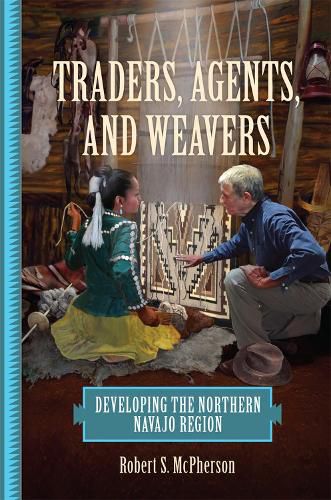Readings Newsletter
Become a Readings Member to make your shopping experience even easier.
Sign in or sign up for free!
You’re not far away from qualifying for FREE standard shipping within Australia
You’ve qualified for FREE standard shipping within Australia
The cart is loading…






For travelers passing through northern Navajo country, the desert landscape appears desolate. The few remaining Navajo trading posts, once famous for their bustling commerce, seem unimpressive. Yet a closer look at the economic and creative activity in this region, which straddles northeastern Arizona, northwestern New Mexico, and southeastern Utah, belies a far more interesting picture. In Traders, Agents, and Weavers, Robert S. McPherson unveils the fascinating-and at times surprising-history of the merging of cultures and artistic innovation across this land.
McPherson, the author of numerous books on Navajo and southwestern history, narrates here the story of Navajo economic and cultural development through the testimonies of traders, government agents, tribal leaders, and accomplished weavers. For the first half of the twentieth century, trading posts dominated the Navajo economy in northwestern New Mexico. McPherson highlights the Two Grey Hills post and its sister posts Toadlena and Newcomb, which encouraged excellence among weavers and sold high-quality rugs and blankets. Parallel to the success of the trading industry was the establishment of the Northern Navajo or Shiprock Agency and Boarding School. The author explains the pivotal influence on the area of the agency’s stern and controversial founder, William T. Shelton, known by Navajos as Tall Leader.
Through cooperation with government agents, American settlers, and traders, Navajo weavers not only succeeded financially but also developed their own artistic crafts. Shunning the use of brightly dyed yarn and opting for the natural colors of sheep’s wool, these weavers, primarily women, developed an intricate style that has few rivals. Eventually, economic shifts, including oil drilling and livestock reduction, eroded the traditional Navajo way of life and led to the collapse of the trading post system. Nonetheless, as McPherson emphasizes, Navajo weavers have maintained their distinctive style and method of production to this day.
$9.00 standard shipping within Australia
FREE standard shipping within Australia for orders over $100.00
Express & International shipping calculated at checkout
For travelers passing through northern Navajo country, the desert landscape appears desolate. The few remaining Navajo trading posts, once famous for their bustling commerce, seem unimpressive. Yet a closer look at the economic and creative activity in this region, which straddles northeastern Arizona, northwestern New Mexico, and southeastern Utah, belies a far more interesting picture. In Traders, Agents, and Weavers, Robert S. McPherson unveils the fascinating-and at times surprising-history of the merging of cultures and artistic innovation across this land.
McPherson, the author of numerous books on Navajo and southwestern history, narrates here the story of Navajo economic and cultural development through the testimonies of traders, government agents, tribal leaders, and accomplished weavers. For the first half of the twentieth century, trading posts dominated the Navajo economy in northwestern New Mexico. McPherson highlights the Two Grey Hills post and its sister posts Toadlena and Newcomb, which encouraged excellence among weavers and sold high-quality rugs and blankets. Parallel to the success of the trading industry was the establishment of the Northern Navajo or Shiprock Agency and Boarding School. The author explains the pivotal influence on the area of the agency’s stern and controversial founder, William T. Shelton, known by Navajos as Tall Leader.
Through cooperation with government agents, American settlers, and traders, Navajo weavers not only succeeded financially but also developed their own artistic crafts. Shunning the use of brightly dyed yarn and opting for the natural colors of sheep’s wool, these weavers, primarily women, developed an intricate style that has few rivals. Eventually, economic shifts, including oil drilling and livestock reduction, eroded the traditional Navajo way of life and led to the collapse of the trading post system. Nonetheless, as McPherson emphasizes, Navajo weavers have maintained their distinctive style and method of production to this day.